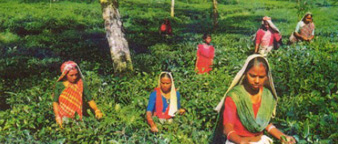|
|
| Tea Plantation & Forest |
Sylhet, a Holy City and the land of “Two leaves and bud” with deep forest and Tribal people.
Sylhet is an ancient settlement area. It was know as Jalalabad in Sultan period. Many historians think that Sylhet was an expanded commercial center from the ancient period. In the 14 th century, Muslim saint from Yemen Hazrat Shah Jalal (R) triumphed Sylhet and began to spread Islam. The shrine of this great saint is located at Sylhet town, that's why Sylhet is considered to be a holy city by the Muslims.
Sylhet town is located 346 km northeast of Dhaka between Khasi-Jaintia Hills and Tripura Hills. Sylhet division is famous for high quality tea production. Tea, a very popular beverage made from the leaves of evergreen shrub or tree Camellia sinensis, family Theaceae. It is predominantly an agro-based export-oriented evergreen crop in Bangladesh and a perennial crop grown as a monoculture on large contiguous areas. Under natural conditions, a tea plant grows to a small tree but it is configured into a bush by sequential pruning and other silvicultural practices, viz tipping, plucking and by harvesting the optimum vegetative produce. Known in China as early as 2737 BC, tea was first brought to Europe in 1610 and rapidly became a fashionable drink.
|
 |
| |
Sreemangal upazila under Maulvi Bazar district about 80 km south of Sylhet Most of the tea gardens in Bangladesh are situated in Sreemangal, that’s why it is also called Capital city of tea. In Sreemangal, there is also a National Tea Research Institute. The annual average rainfall in Sylhet (3334 mm) is higher than other parts of Bangladesh which helps for quality tea production. In a tea garden, you will find an extremely exceptional natural beauty with rich tropical forest and many types of wildlife, scented orange groves and pineapple plantations. It is also the home of tribal people. The Lawacharra forest, 5 km away from Sreemangal, where you can see the different wildlife and deep forest.
Tamabil-Jafflong, a border outpost on the Sylhet - Shilong (India) road, about 54 km east from Sylhet town, has exceptional beauty for its location bearing a river which divided Bangladesh and India. Tamabil attracts tourists for its most beautiful spots, the hilly region is deeply forested, with clear water streams that turn into rapids during monsoon. Big boulders and stones from the Khasia-Jayantia hills fill the valley. The valley is ringed by tea gardens and orange and grapefruit plantation. Some tribal people lived here. They are Khashia and Monipuri Chakma. Madhabkunda, the place offers spectacular view of waterfalls down the hill which is located under Maulvi Bazar district is very nice place to visit.
Sylhet is linked with Dhaka by Rail, Road and Air.
|
|
|
|